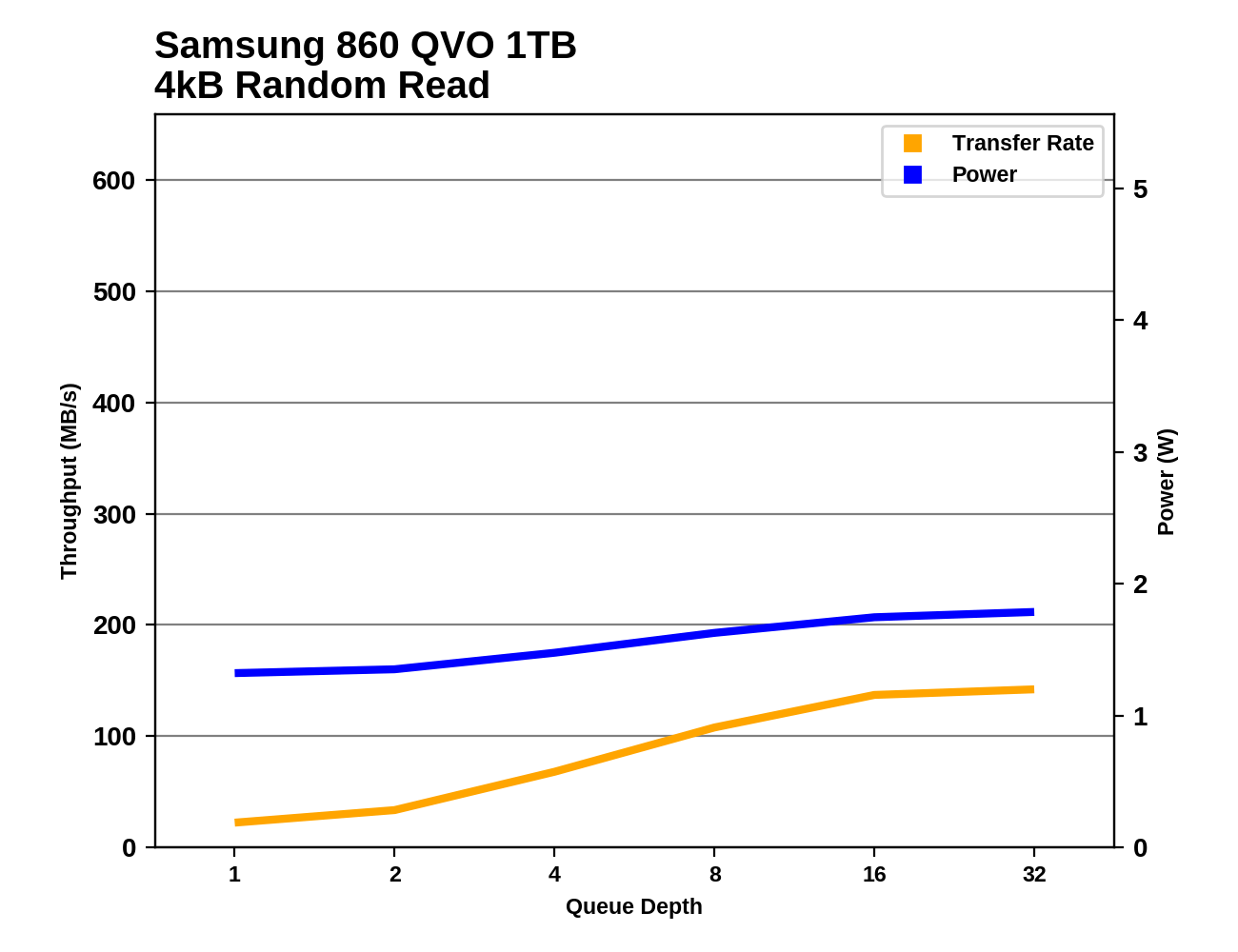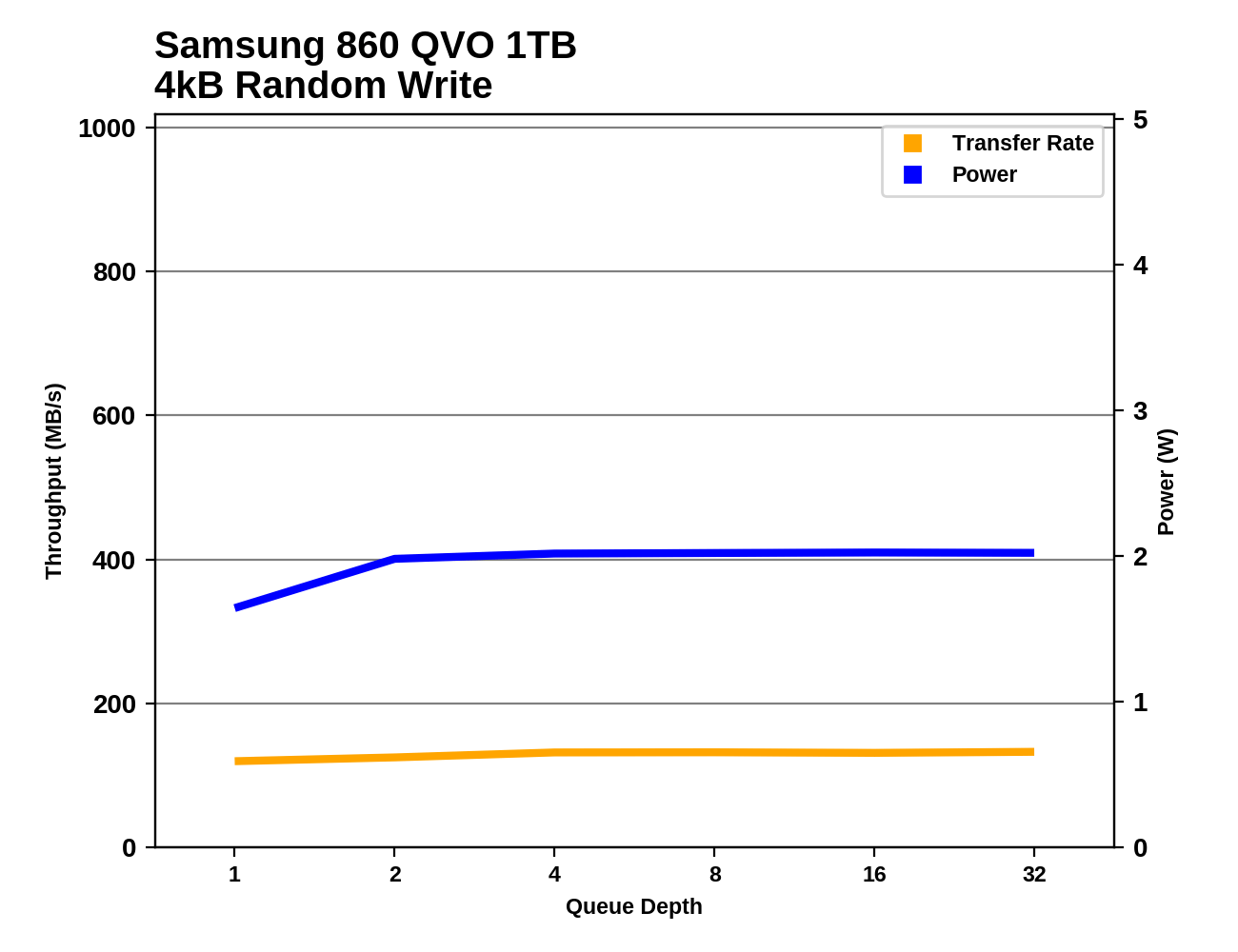The Samsung 860 QVO (1TB, 4TB) SSD Review: First Consumer SATA QLC
by Billy Tallis on November 27, 2018 11:20 AM ESTRandom Read Performance
Our first test of random read performance uses very short bursts of operations issued one at a time with no queuing. The drives are given enough idle time between bursts to yield an overall duty cycle of 20%, so thermal throttling is impossible. Each burst consists of a total of 32MB of 4kB random reads, from a 16GB span of the disk. The total data read is 1GB.

The burst random read performance of the Samsung 860 QVO is clearly lower than the 3D TLC competition, while the Intel/Micron QLC NVMe drives have no trouble competing against the field of mainstream SATA TLC drives. Even in the worst case of the smallest QVO being entirely full, read speeds are still vastly better than a hard drive.
Our sustained random read performance is similar to the random read test from our 2015 test suite: queue depths from 1 to 32 are tested, and the average performance and power efficiency across QD1, QD2 and QD4 are reported as the primary scores. Each queue depth is tested for one minute or 32GB of data transferred, whichever is shorter. After each queue depth is tested, the drive is given up to one minute to cool off so that the higher queue depths are unlikely to be affected by accumulated heat build-up. The individual read operations are again 4kB, and cover a 64GB span of the drive.

On the longer random read test, the Toshiba TR200 DRAMless TLC drive is no longer able to stay ahead of the 860 QVO, and even the Intel/Micron QLC drives fall behind most mainstream SATA drives (especially when full).
 |
|||||||||
| Power Efficiency in MB/s/W | Average Power in W | ||||||||
The power consumption of the 860 QVO during the random read test is only slightly higher than its TLC-based relatives, but that's plenty to push its efficiency scores into last place, given the poor performance.
 |
|||||||||
The queue depth scaling of the 860 QVO during random reads is fairly typical in shape, with improvements starting to taper off after QD16. However, the vertical scale is important: the QVO doesn't ever reach even half the performance of the best TLC-based SATA SSDs.
Looking at the 1TB 860 QVO's random read results compared to all the other SATA drives in the benchmark database, it is clear that the QVO isn't anywhere near the cutting edge for power efficiency or peak performance, but there are worse drives out there.
Random Write Performance
Our test of random write burst performance is structured similarly to the random read burst test, but each burst is only 4MB and the total test length is 128MB. The 4kB random write operations are distributed over a 16GB span of the drive, and the operations are issued one at a time with no queuing.

The SLC cache of the 860 QVO is very effective for the burst random write test, leaving it tied or slightly ahead of the 860 EVO.
As with the sustained random read test, our sustained 4kB random write test runs for up to one minute or 32GB per queue depth, covering a 64GB span of the drive and giving the drive up to 1 minute of idle time between queue depths to allow for write caches to be flushed and for the drive to cool down.

On the longer random write test, the larger SLC cache and greater parallelism of the 4TB 860 QVO helps it keep pace with other top SATA SSDs, but the 1TB QVO has to settle for being slightly faster than the DRAMless TLC drive.
 |
|||||||||
| Power Efficiency in MB/s/W | Average Power in W | ||||||||
The QVO is again a bit more power hungry than most of the TLC drives, which doesn't hurt the 4TB QVO's efficiency score much thanks to its good performance, but the 1TB QVO ends up tied for last place with the full-drive performance from the Intel/Micron QLC drives.
 |
|||||||||
The 1TB 860 QVO shows very little random write performance scaling with increasing queue depth, though power consumption does go up significantly from QD1 to QD2. The 4TB 860 QVO shows a much more typical scaling up to saturation at QD4, with a performance curve that is almost an exact match for the 4TB 860 EVO.
There are some TLC SATA SSDs that draw the same power to deliver half the random write performance of the 1TB 860 QVO, but in the grand scheme of things the 1TB QVO's results on this test are sub-par. The 4TB starts out in the same spot but ends up hitting the SATA performance wall without consuming too much power.












109 Comments
View All Comments
Morawka - Wednesday, November 28, 2018 - link
I just had 2 Samsung QLC 3 bit drives die this year alone. They were less than 1.5 year old. I'm never buying Samsung's EVO line again. It will be Pro from here on out. 4 bit drives will fail even faster.Makaveli - Wednesday, November 28, 2018 - link
Which model evo's were those Morawka?And how many writes did they see? what kind of environment did you have them in?
stephenbrooks - Wednesday, November 28, 2018 - link
I was starting to get excited about 2TB for $300 but then I looked up 2TB HDDs and they're about $60. Still a huge price differential especially as I usually want at least one extra drive for nightly backups, although perhaps the backup drive could be the HDD?Lolimaster - Thursday, November 29, 2018 - link
Even with the right capacities for a QLC price is similar or worse than current TLC.Samsunf 860 EVO 1TB $127
For QLC to make sense it should HALF of a TLC else is a ripoff.
s.yu - Friday, November 30, 2018 - link
What's the point of trying to pronounce it? It's just Q-V-O!araczynski - Friday, November 30, 2018 - link
so basically next black friday these should be half price and the 4tb might be worthy of consideration as a Steam drive.thomas-hrb - Friday, November 30, 2018 - link
$149.99 launch price is encouraging even if it is currently more than the 860evo. The 860evo launched for over $300 (closer to $330) and is now $139. If the qvo follows this pattern we can look forward to sub $65 for the 1tb qvo and maybe even $250 for 4tb.Ankou - Friday, November 30, 2018 - link
I think these QLC drives are a bad idea especially in the way they're being marketed. I'm not even talking about performance, the speed reduction I could live with. However, they're orders of magnitude worse in P/E cycles, retention, and endurance. These manufacturers know this and they're preying on the lack of education and focusing on price. Even so far as advertising these drives (this one in particular) as using 4 bit MLC memory (which 4 bit MLC is *always* QLC) implying that it is on safer MLC memory:https://news.samsung.com/global/samsung-electronic...
That is completely a scummy marketing/PR way of doing business.
s.yu - Saturday, December 1, 2018 - link
The fundamental issue is that 2-bit MLC should have been accurately named DLC in the first place, it's not like somebody's gonna mix that up with downloadable content.0ldman79 - Saturday, December 15, 2018 - link
Could we get some numbers from some mechanical drives, WD or Seagate 1TB or 2TB, in comparison to the slower QLC drives?I'd like to see how they hold up against the QLC in random and sustained reads/writes. The latency might be the deciding factor even though I've got some mechanical drives that can beat them on sustained reads/writes.